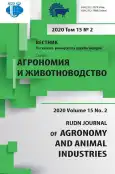Reducing plant damage as a way to protect the biosphere from pollution by chemically hazardous effects
- Autores: Meznikova M.V.1, Borisenko I.B.1, Chamurliev O.G.1, Chamurliev G.O.2, Idrisova L.S.2
-
Afiliações:
- Volgograd State Agricultural University
- Peoples’ Friendship University of Russia
- Edição: Volume 15, Nº 2 (2020)
- Páginas: 173-181
- Seção: Soil science and agrochemistry
- URL: https://journal-vniispk.ru/2312-797X/article/view/316893
- DOI: https://doi.org/10.22363/2312-797X-2020-15-2-173-181
- ID: 316893
Citar
Texto integral
Resumo
In difficult economic realities, the primary task in growing crops is to reduce costs in compliance with quality requirements. At the same time, environmental safety issues are becoming more and more obvious. Lack of knowledge or poor technical settings often result in catastrophic consequences due to unreasonable chemicals application and increases emergency risks in agriculture. In this regard, chemical plant protection requires special attention in terms of safety management. The method of strip chemical treatment of crops reduces the effects of chemically hazardous substances on plants, emphasizing the importance and relevance of the research direction. Based on the analysis of production costs for chemical treatment, the shortcomings of serial machines for chemical plant treatment were identified. A technology and technical solution for strip spraying with redistribution of operating solutions to the exposure objects, considering plant growth stage, were proposed. It allowed to accurately adding the active substance to the object, which caused decrease in application rate per hectare, reduction of plant stress, and saving in costs for chemical treatment. Simultaneously, it contributed to the solution of environmental problems by reducing chemical load on soil. This method reduces the risk of emergencies when using chemically hazardous substances in agriculture.
Sobre autores
Marina Meznikova
Volgograd State Agricultural University
Autor responsável pela correspondência
Email: bgd_meznikova@mail.ru
Associate Professor, Department of Life Safety
Volgograd, Russian FederationIvan Borisenko
Volgograd State Agricultural University
Email: borisenivan@yandex.ru
Doctor of Technical Sciences, Senior Researcher, Department of Agriculture and Agricultural Chemistry
Volgograd, Russian FederationOmariy Chamurliev
Volgograd State Agricultural University
Email: attika.ge@yandex.ru
Doctor of Agricultural Sciences, Professor, Head of the Department of Agriculture and Agrochemistry
Volgograd, Russian FederationGeorgy Chamurliev
Peoples’ Friendship University of Russia
Email: giorgostsamourlidis@mail.ru
Candidate of Agricultural Sciences, senior lecturer, Agroengineering Department, Agrarian and Technological Institute
Moscow, Russian FederationLucia Idrisova
Peoples’ Friendship University of Russia
Email: idrisova_ls@pfur.ru
PhD student, Department of Technosphere Security, Agrarian and Technological Institute
Moscow, Russian FederationBibliografia
- Belenkov AI, Tyumakov AY, Sabo MU. Precision (coordinate) agriculture the Russian State Agricultural University Timiryazev Moscow Agricultural Academy: reality and prospects. Bulletin of Altai State Agricultural University. 2015; (4):5—10. (In Russ.)
- Melnik VI. The evolution of farming system — a look into the future. Zemledelie. 2015; (1):8—12. (In Russ.)
- Zubarev YN. “Green revolution” — the factor of the progress of agriculture. Perm Agrarian journal. 2014; 3 (7):17—21. (In Russ.)
- Borisenko IB, Shaprov MN, Borisenko PI. Agrotechnical approaches in the design of the working part for minimum tillage with strip deepening. Proceedings of Nizhnevolzskiy agrouniversity complex: science and higher vocational education. 2013; (4):193—197. (In Russ.)
- Borisenko IB, Filin VI, Meznikova MV, Ulybina EI. Effectiveness of chemical strip technology and necessary modernization of the sprayer for its implementation. Priority research and innovative technologies in the agricultural sector: science — production: proceedings of the National Scientific and Practical Conference, Volgograd, October 29, 2019. Volume 3. Volgograd: Volgograd State Agrarian University Publ.; 2019. p. 18—24. (In Russ.)
- Zavrazhnov AI, Balashov AV, Dyachkov SV, Omarov AN, Strykin SP. Determination of design parameters of applicators for local processing of sugar beet crops. Achievements of science and technology in Agro‑Industrial complex. 2017; 31(1):52—55. (In Russ.)
- Canales E, Bergtold J, Williams J. Modeling the Choice of Tillage Used for Dryland Corn, Wheat and Soybean Production by Farmers in Kansas. Agricultural and Resource Economics Review. 2018; 47(1), 90—117. doi: 10.1017/age.2017.23
- Borisenko IB, Meznikova MV. Using the Strip-Till resource-saving technology in sorghum growing. Izvestia Orenburg state agrarian university. 2015; 6 (56):82—84. (In Russ.)
- Meznikova MV, Borisenko IB, Ulybina EI, Boyarkina OV. Improving the effi of chemical processing of row crops in the framework of strip technology. RUDN Journal of Agronomy and Animal Industries. 2019; 14(4):453—465. (In Russ.) doi: 10.22363/2312-797X-2019-14-4-453-465
- Jaskulska I, Gałęzewski L, Piekarczyk M, Jaskulski D. Strip-till technology — a method for uniformity in the emergence and plant growth of winter rapeseed (Brassica napus L.) in different environmental conditions of Northern Poland. Italian Journal of Agronomy. 2018; 13(3):194—199. doi: 10.4081/ija.2018.981
- Mi GH, Wu DL, Chen YL, Xia TT, Feng GZ, Li Q, et al. The Ways to Reduce Chemical Fertilizer Input and Increase Fertilizer Use Efficiency in Maize in Northeast China. Scientia Agricultura Sinica. 2018; 51(14):2758—2770. doi: 10.1016/j.ejca.2010.10.025
- Borisenko IB, Meznikova MV, Ulybina EI. New technologies for the use of a sprayer. Selskiy Mechanizator. 2019; (8): 4—5. (In Russ.)
- Borisenko IB, Chamurliev OG, Chamurliev GO, Meznikova MV. Evaluation of the effectiveness of strip tillage technology. RUDN Journal of Agronomy and Animal Industries. 2018; 13(3):194—206. (In Russ.) doi: 10.22363/2312-797X-2018-13-3-194-206
- Meznikova MV. Study of the problems of plant protection from chemically hazardous effects in emergency situations. Vestnik NTsBZhD. 2019; (2):98—104. (In Russ.)
- Lukmenev VP. Influence of fertilizers, fungicides and growth regulators on sunflower yields. Izvestia Orenburg state agrarian university. 2015; (1):41—46. (In Russ.)
- Borisenko IB, Ovchinnikov AS, Meznikova MV, Fomin SD, Bocharnikov VS, Rogachev AF, Ulybina EI. Resource-saving method of chemical treatment of tilled crops. In: Conference on Innovations in Agricultural and Rural development, 18—19 April, 2019, Kurgan, Russian Federation. IOP Conf. Series: Earth and Environmental Science. Volume 341. IOP Publishing; 2019. doi: 10.1088/1755–1315/341/1/012092
- Borisenko IB, Ovchinnikov AS, Chamurliev OG, Filin VI, Meznikova MV, Ulybina EI. Sposob polosovoi khimicheskoi obrabotki rastenii [Method for strip processing of plants]. Patent RUS, no. 2709762, 2019. (In Russ.)
Arquivos suplementares










